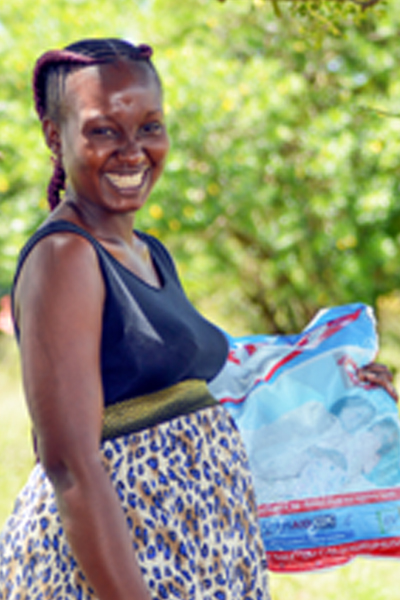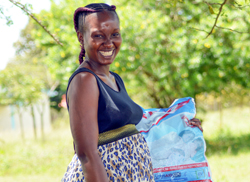
“How do we ensure that Universal Health Coverage is possible in Kenya by 2022? The answer is simple,” so wrote Dr Werner Schultink, the Unicef Representative to Kenya, Dr Rudi Eggers, WHO Representative to Kenya, and Mr Siddharth Chatterjee, the UN Resident Coordinator to Kenya. “The focus has to be on preventable and primary healthcare as emphasised in the Alma-Ata principles. The centrality of reproductive, maternal, neonatal, child and adolescent health will be critical to achieving UHC,” they stated.
Writing in an opinion article that was widely distributed in several publications, the career development workers gave two reasons why maternal and child health is a forerunner of UHC:
“First, it is clear that the mother’s overall state of health has a lifetime impact on an individual child’s health. Second, there is now evidence that households with maternal health complications spend considerably more of their savings to cover medical expenses. This is particularly key in rural settings where women play major economic roles.”
Indeed, Kenya loses about 20 women every day while giving birth, majority from preventable causes. This means 20 families and households are left without their primary caregiver and, in many instances, sole breadwinner. The death of a mother is not only a loss to that household, but also to the whole country, both socially and economically.
It is for this reason that reproductive and maternal, newborn and child health is rated high in the global health card. In its 16 essential health services, the World Health Organisation puts reproductive, maternal, newborn and child health in its first four categories: family planning, antenatal care and delivery care, full child immunisation and health seeking behaviour for pneumonia.
In October 2018, Kenya hosted the African Union Conference on Maternal Health.
In her speech, and in an opinion article published in local newspapers, CS Kariuki expounded on the relationship between universal health coverage, family planning and maternal health. She said that through Universal Health Coverage, Kenya’s goal is to ensure that every mother and child has access to free quality health services and that mothers continue to have access to skilled delivery.
Around the world, mothers and children continue to die needlessly of preventable causes. The global community and specifically the African Union have prioritised maternal, adolescent and child health as an urgent area of focus.
“We have eliminated financial barriers to skilled delivery through the Linda Mama programme (formerly free maternal healthcare programme),” said the CS, “but we need to improve on geographical accessibility. I urge the county governments and the private sector to invest towards Primary Health Care in line with our reaffirmation in Astana, in the just-concluded Global Primary Health Care Conference.”
Connected to this are diseases that kill women and children. Kenya stands proud that it was certified free of maternal and neonatal ill-health early in 2018. It was set to be free of polio, but experienced shocks when a strain of polio was recently discovered in Nairobi’s Eastleigh area. The government has since intensified immunisation, including reaching under-five children who might have missed immunisation during the nurses and doctors strikes in 2017.
On immunisation, Kenya has expanded the programme by introducing two new vaccines, Rota virus vaccine against diarrhoea, and Inactivated Polio Vaccine (IPV) to accelerate efforts towards polio eradication.
In 2019, Kenya introduced the Human Papilloma Virus (HPV) vaccine that is expected to reduce cervical cancer cases. Cervical cancer is one of the leading causes of death in women.
Family planning
In 2012, countries gathered at the London Summit on Family Planning where they made commitments that came to be known as FP2020 to address the policy, financing, delivery and socio-cultural barriers to women accessing contraceptive information, services and supplies.
Since then, Kenya has made great progress towards increased uptake of family planning, having recently exceeded its 2020 target of 58 percent modern contraceptive use by married women.
With this achievement, the government has focused its attention on the counties, where budget allocations for family planning have increased. According to the Ministry of Health, women living in rural areas have higher levels of unmet needs for family planning, at 27 percent, compared with those living in urban areas, at 20 percent. Higher unmet needs in rural areas reflect the more limited availability and acceptability of family planning among women.
In relation to the Universal Health Coverage, access to family planning is key because, when women are allowed to plan when and the number of children to have, there are better health outcomes.
In the counties for instance, where most women, due to culture and lack of access, do not access FP services, the fertility rate is high, from nine children per woman compared with three in the towns and cities.
Also, adolescents and teenage pregnancies in Kenya are high at 18 percent, which is estimated as nine underage girls getting pregnant every day. Access to comprehensive sex education, including contraception, is seen as key in reducing teenage pregnancy and, subsequently, maternal deaths as young girls’ bodies are not yet well formed to sustain giving birth. Many die during childbirth, contributing to the high cases of maternal deaths.
Indeed, the figures by the Ministry of Health show that there is a high unmet need for family planning among young women aged 15-29 years, and who are in the more fertile age group and have high levels of unintended pregnancies. Unmarried, sexually active adolescents in particular have difficulties in accessing contraceptives.
Nearly half, 47 percent of births, among Kenyan adolescents aged 15-19 are unintended – wanted later or not at all. Younger women are also more likely than older women to have an unmet need for spacing because they are more apt to want more children.
The World Health Organisation recommends that adolescent girls and young women are medically eligible to use any contraceptive method.
However, most young women are not able to access contraceptive services, largely due to societal stigma and perception.
This is the reason the Ministry of Health is keen on the community-based distribution model for FP commodities. In this regard, community health volunteers or workers are seen as key in circumventing such challenges. Community volunteers go from door to door, are respected in the communities (we will see this in a subsequent subtopic), thus increasing uptake and ensuring continuation.
The CBD model sits well with the Primary Health Care goal of Universal Health Coverage. Currently, the MOH is working on a curriculum for community health workers. The draft is comprehensive – training the CBDs on what family planning is, reproductive health, communication skills and contraceptive methods.
Free maternity care (Linda Mama)
In one of his earliest commitments, President Uhuru Kenyatta during the Madaraka Day celebrations of June 1, 2013, abolished maternity fees for mothers delivering at public facilities in Kenya.
There was a sigh of relief from across the country, and immediately health centres experienced an influx of women seeking to deliver. In an opinion article, Health Cabinet Secretary Sicily Kariuki said that, as a result, skilled hospital-based deliveries increased by over 20 percent and more than two thirds of all deliveries were conducted by skilled healthcare workers.
Deliveries in health facilities increased from 600,323 in 2013 to 1.2 million in 2016, while use of primary healthcare services rose from 69 per cent in the financial year 2013/2014 to 77 per cent in 2015/2016 as a result.
According to Lancet, this is proof that hospital cost was a barrier to maternal healthcare, with many women giving birth at home at increased risk.

month after the President’s declaration, the government committed Ksh3.8 billion to the programme, with an additional Ksh700 million for free access to health centers and dispensaries. With the increased uptake of these services, there was a need for more investment in human resource and infrastructure. Thus the government added Ksh3.1 billion for recruitment of 30 community nurses per constituency, Ksh522 million for recruitment of community health workers per constituency and Ksh1.2 billion for housing of the workers.
The funds would initially be reimbursed to the county governments, depending on the claims they forwarded to the national government showing the number of women who had given birth in their facilities.
But this changed on October 18, 2016, when the Ministry of Health shifted the programme from direct reimbursement to an insurance-based plan to be administered by NHIF. Now branded Linda Mama, Boresha Jamii, the programme expanded from public hospitals to include private and faith-based providers. The programme officially transitioned to NHIF on April 1, 2017.
The benefit package also expanded from free deliveries to include other aspects of pregnancy, including covering the recommended four antenatal care visits, delivery (normal and caesarian section) as well as four post-natal services. Eligibility was simple; all pregnant women in Kenya simply register through the USSD code *263# with minors registering under their parents’ or guardians’ names.
What this means is that women seeking medical care while pregnant get far-reaching and life-saving benefits for free. Besides blood group and rhesus tests, these services include screening for tuberculosis, testing for HIV, and counselling. Women who test HIV positive are immediately put on the Prevention of Mother-to-Child Transmission, PMTCT programme, and are administered with ARVS. Women are also given iron and folate, which boost the health of infants.
Additionally, women in malaria endemic areas are treated for malaria and issued with treated mosquito nets.
Postnatal care is given in four scheduled visits, where the mother again gets iron and folate, treatment for HIV if positive, and receives advice on family planning, care for the new-born and on the need for spacing the next birth. Infants get vital immunisation, including ‘birth polio’, and, if born with HIV, are treated.
However, critics of the Linda Mama programme say that since health is a devolved function, free maternity care should be managed by counties. The Ministry of Health, meanwhile, is upbeat that the programme has been a success so far.
During the launch of the Linda Mama programme, the Cabinet Secretary said Kenya is the only country that has met four out five WHO nutritional goals in the period 2013 to 2016. Stunting reduced from 35 percent to 26 percent, while exclusive breastfeeding improved from 32 percent to 61 percent. Under-five mortality declined from 115 to 52, translating to 30,000 lives saved. Neonatal mortality also declined from 33 to 22 per 1,000 live births over the same period. Vaccination coverage for fully immunised children went up to 76 percent from 68 percent in 2013/14.
In the same period, maternal mortality dropped from 488 per 100,000 births to 362 per 100,000 births. This represents 2,000 mothers’ lives saved. Primary healthcare utilisation increased from 69 percent in the financial year 2013 to 77 percent in 2016 following waiver of user fees.
The NHIF has also cited challenges caused by the programme, including delays and defaults in payment of insurance premiums due to the free service, mainly by people in the informal sector. Private and faith-based facilities have recorded slow uptake of the programme, citing low reimbursement rates compared with the national maternity programme. Some counties have also shown resistance to NHIF.
Surprisingly, in media stories following the launch of Linda Mama, most mothers quoted said they did not know about the programme. This is a wake-up call to NHIF, and indeed the government, to invest more in communicating its initiatives through the media and other forums like this Yearbook.
